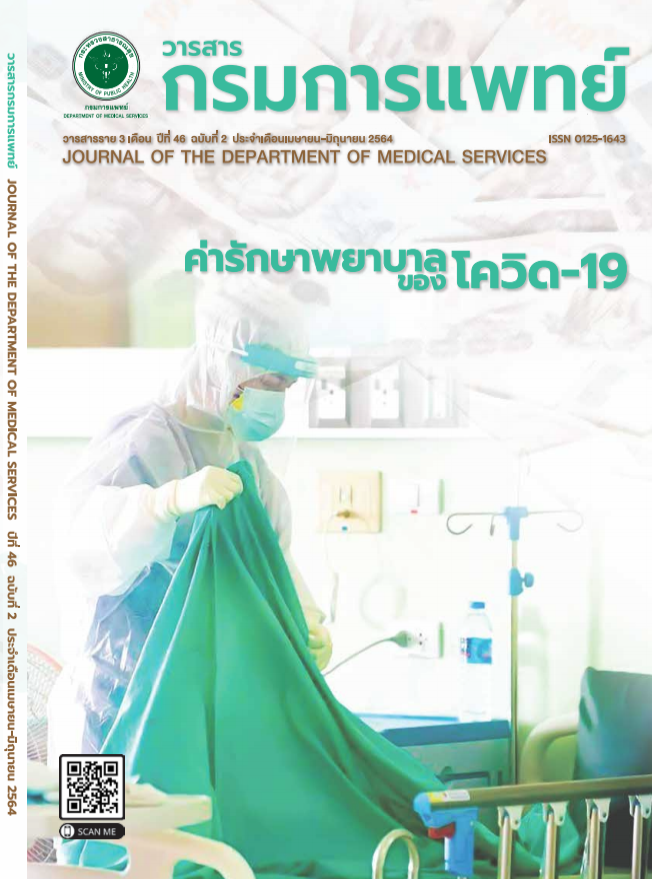ผลของการเปลี่ยนแนวทางอนุมัติยา vancomycin ต่อแบบแผนความไวของเชื้อ group D enterococci: ประสบการณ์ในโรงพยาบาลเฉพาะทางด้านระบบประสาท
คำสำคัญ:
การควบคุมกำกับดูแลการใช้ยาต้านจุลชีพอย่างเหมาะสม, การหยุดยา vancomycin อัตโนมัติ, การขออนุมัติก่อน จ่ายยา group D Enterococci, โรงพยาบาลเฉพาะทางด้านประสาทวิทยาบทคัดย่อ
ภูมิหลัง: การควบคุมกำกับดูแลการใช้ยาต้านจุลชีพอย่างเหมาะสม (antibiotic stewardship program; ASP) เป็นกระบวน การที่สำคัญอันหนึ่งในการลดอัตราการดื้อยาของเชื้อก่อโรคในโรงพยาบาล ในอดีตที่ผ่านมา ได้เคยมีการใช้วิธีตรวจสอบการใช้ยาต้าน จุลชีพย้อนหลัง (retrospective audit) และเสนอแนะแนวทางที่เหมาะสม (feedback) แต่จากรายงานแบบแผนความไวของเชื้อต่อยา ต้านจุลชีพในเวลาต่อมาพบว่า อัตราการใช้ vancomycin ยังเพิ่มขึ้นอย่างมีนัยสำคัญ ร่วมกับความไวต่อยาต้านจุลชีพของเชื้อแบคทีเรีย กลุ่ม D enterococci ก็ลดลงจาก 100 เปอร์เซ็นต์เป็น 96 เปอร์เซ็นต์วัตถุประสงค์: ศึกษาวิธีการควบคุมยาปฏิชีวนะ (ASP) ที่สามารถ ลดอัตราการใช้ยา vancomycin และช่วยเพิ่มความไวต่อยาต้านจุลชีพ vancomycin ของเชื้อ group D enterococciวิธีการ: เป็นการ ศึกษาย้อนหลังโดยการสังเกตเชิงพรรณนา ในผู้ป่วยจำนวน 442 ราย ที่เข้ารับการรักษา ในโรงพยาบาลตั้งแต่ 1 มกราคม 2557 ถึง 31 ธันวาคม 2560 ที่ได้รับ vancomycin injection โดยกลุ่มที่ได้ยาตั้งแต่ 1 มกราคม 2557 ถึง 31 พฤศจิกายน 2558 จำนวน 215 ราย จะถูกตรวจสอบ การใช้ยาต้านจุลชีพย้อนหลัง (retrospective audit) และเสนอแนะแนวทางที่เหมาะสม (feedback) ส่วนกลุ่มที่ได้รับ ยาตั้งแต่ 1 ธันวาคม 2558 ถึง 31 ธันวาคม 2560 จำนวน 227 ราย จะถูกหยุดยาโดย อัตโนมัติภายใน 72 ชั่วโมงหลังเริ่มยา (timeout) หลังจากนั้นหากต้องการใช้ยาต่อ จะต้องขออนุมัติ การใช้ยาจากแพทย์อายุรกรรมก่อน (pre-authorized) แล้วเปรียบเทียบ vancomycin susceptibility ของเชื้อ gr D enterococi และ define daily dose (DDD) ก่อนและหลังการปรับเปลี่ยนผล: หลังจากปรับเปลี่ยน วิธี การใช้ยาเป็นแบบ timeout with pre-authorization พบว่าปริมาณการใช้ยา vancomycin ซึ่งวัดเป็น DDD ต่อ 1,000 วันนอน โรงพยาบาล ลดลงจาก 32.1 และ 44.5 ต่อ 1,000 วันนอนโรงพยาบาล ในปี 2557 และ 2558 เป็น 34.4 และ 39.3 ต่อ 1,000 วันนอน โรงพยาบาล ในปี 2559 และ 2560 ในขณะเดียวกัน แบบแผนความไวของเชื้อ gr D enterococci ต่อยาต้านจุลชีพ vancomycin เพิ่มขึ้นจากร้อยละ 96 และ 95 ตั้งแต่ 2557 และ 2558 เป็นร้อยละ 100 ในปี 2559 และ 2560สรุป: วิธีการควบคุมกำกับดูแลการใช้ ยา vancomycin อย่างเหมาะสม ด้วยวิธีหยุดจ่ายยาอัตโนมัติหลังใช้ 72 ชั่วโมง หลังจากนั้นหากต้องการใช้ยาต่อ จะต้องขออนุมัติก่อน จ่ายยา น่าจะเป็นหนึ่งในวิธีการที่มีประสิทธิภาพสำหรับการควบคุมการดื้อยาของเชื้อ gr D enterococci.
เอกสารอ้างอิง
Yesim C, Pamela F and C. Glen M. Vancomycin-resistant enterococci. Clinical Microbiology Reviews 2000;3(4):686-707.
National Antimicrobial Resistance Surveillance Center Thailand [internet]. Antimicrobial Resistance 2000-2019.[cited 2020 Apr 04]. Available from: http://narst.dmsc.moph.go.th/data/AMR%20 2000-2019-06M.pdf.
The European Centre for Disease Prevention and Control [internet]. Surveillance of antimicrobial resistance in Europe 2017. [cited 2020 Apr 04]. Available from: https://www.ecdc.europa.eu/en/publications-data/surveillance-antimicrobialresistance-europe-2017.
Davey P, Brown E, Fenelon L, Finch R, Gould I, Hartman G, et al. Interventions to improve antibiotic prescribing practices for hospital inpatients. Cochrane Database Syst Rev 2005;:CD003543.
Tamma PD, Cosgrove SE. Antimicrobial stewardship. Infect Dis Clin North Am 2011;25:245–60.
The Centers for Disease Control and Prevention [internet]. The core elements of hospital antibiotic stewardship programs 2019. [cited 2020 Apr 04]. Available from: https://www.cdc.gov/antibiotic-use/healthcare/pdfs/hospital-core-elements-H.pdf.
Brandl K, Plitas G, Mihu CN, Ubeda C, Jia T, Fleisher M, et al.Vancomycin-resistant enterococci exploit antibiotic-induced innate immune deficits. Nature 2008;455:804-7.
Bhavnani SM, Drake JA, Forrest A, Deinhart JA, Jones RN, Biedenbach DJ, et al. A nationwide, multicenter, case-control study comparing risk factors, treatment, and outcome for vancomycin-resistant and -susceptible enterococcal bacteremia.Diagn Microbiol Infect Dis 2000;36:145-58.
National antimicrobial resistance surveillance center Thailand [internet]. Antimicrobial Resistance 2000-2019.[cited 2020 Apr 04]. Available from: http://narst.dmsc.moph.go.th/data/AMR%20 2000-2019-06M.pdf.
Centers of disease control and prevention [internet]. Core elements of hospital antibiotic stewardship programs. [cited 2020 May 23]. Available from: https://www.cdc.gov/antibiotic-use/core-elements/hospital.html.
Ibrahim M, Bazzi Z. A retrospective audit of antibiotic prescriptions in a Lebanese Hospital. International Journal of Infection Control 2019;15:1-10.
Chautrakarn S, Anugulruengkitt S, Puthanakit T, Rattananupong T, Hiransuthikul N. Impact of a prospective audit and feedback antimicrobial stewardship program in pediatric units in tertiary care teaching hospital in Thailand. Hosp Pediatr 2019;9:851-8.
Yeo CL, Wu JE, Chung GW, Chan DS, Chen HH, Hsu LY.Antimicrobial stewardship auditing of patients reviewed by infectious diseases physicians in a tertiary university hospital.Antimicrob Resist Infect Control 2013;2:29.
Wirtz AL, Burns AN, Lee BP, Frank TS, Fitzmaurice L, Ogden RK, et al. Effectiveness and safety of mandatory antimicrobial indications and durations and a pharmacist-driven 48-hour time-out in a pediatric hospital. Am J Health Syst Pharm 2020;77:614–21.
Graber CJ, Jones MM, Glassman PA, Weir C, Butler J, Nechodom K, et al. Taking an antibiotic time-out:Utilization and usability of a self-stewardship time-out program for renewal of Vancomycin and Piperacillin-Tazobactam. Hosp Pharm 2015;50:1011–24.
Mehta JM, Haynes K, Wileyto EP, Gerber JS, Timko DR, Morgan SC, et al. Comparison of prior authorization and prospective audit with feedback for antimicrobial stewardship. Infect Control Hosp Epidemiol 2014;35:1092-9.
Chung GW, Wu JE, Yeo CL, Chan D, Hsu LY. Antimicrobial stewardship: a review of prospective audit and feedback systems and an objective evaluation of outcomes. Virulence 2013;4:151-7.
ดาวน์โหลด
เผยแพร่แล้ว
รูปแบบการอ้างอิง
ฉบับ
ประเภทบทความ
สัญญาอนุญาต

อนุญาตภายใต้เงื่อนไข Creative Commons Attribution-NonCommercial-NoDerivatives 4.0 International License.
บทความที่ได้รับการตีพิมพ์เป็นลิขสิทธิ์ของกรมการแพทย์ กระทรวงสาธารณสุข
ข้อความและข้อคิดเห็นต่างๆ เป็นของผู้เขียนบทความ ไม่ใช่ความเห็นของกองบรรณาธิการหรือของวารสารกรมการแพทย์



